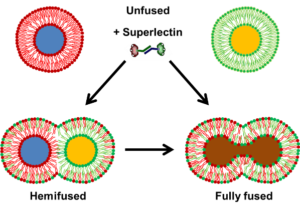
ESR4
Basic mechanisms and applications of lectin-triggered membrane fusion
Lina Siukstaite
 This project seeks to explain the mechanism(s) of lectin-triggered membrane fusion and killing of cancer cells by fusion of liposomes with target cells.
This project seeks to explain the mechanism(s) of lectin-triggered membrane fusion and killing of cancer cells by fusion of liposomes with target cells.
All cells are covered with a coating of complex carbohydrates (the glycocalyx) and many viruses, bacteria and protein toxins produced by bacteria exploit this sugar coating as a means of binding to and entering their target cells. The glycocalyx on many living cells extends >100 nm from the cell membrane, and its outer portion is dominated by proteoglycans and mucins which have extended and highly glycosylated structures. Interactions of proteins with these glycosylated structures is important for cellular interactions and also may influence the ability of bacterial toxins to reach their primary receptors on the cell membrane.
The aim of this project is to incorporate glycoconjugates and lectins into the membrane of artificial cells (protocells) and employ them for diverse membrane fusion studies, i.e. for fusion of two protocells, but also of a protocell with a cancer cell. Through this interdisciplinary project you will develop skills in cell biology, immunology, membrane biology, glycobiology, biochemistry, and advanced microscopy techniques.
Appropriate training will be provided in all areas that are new to the researcher.

University of Freiburg
Supervisor Prof Winfried Römer
